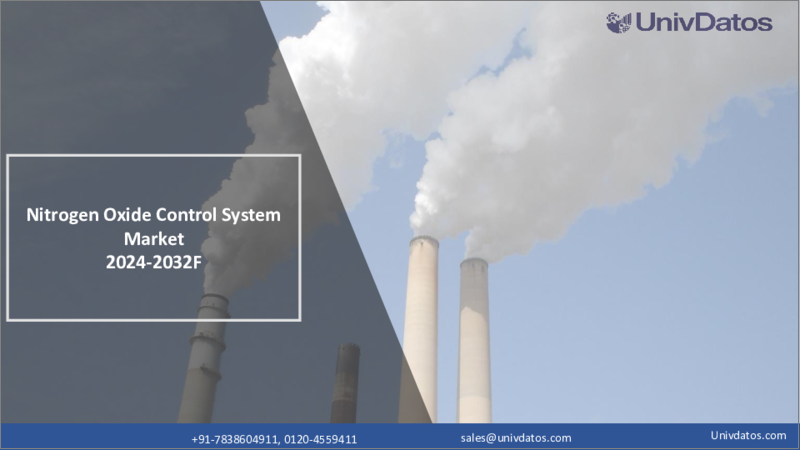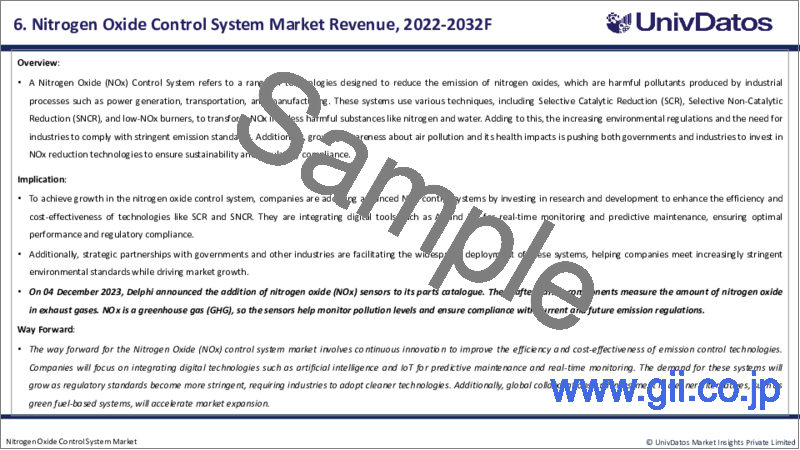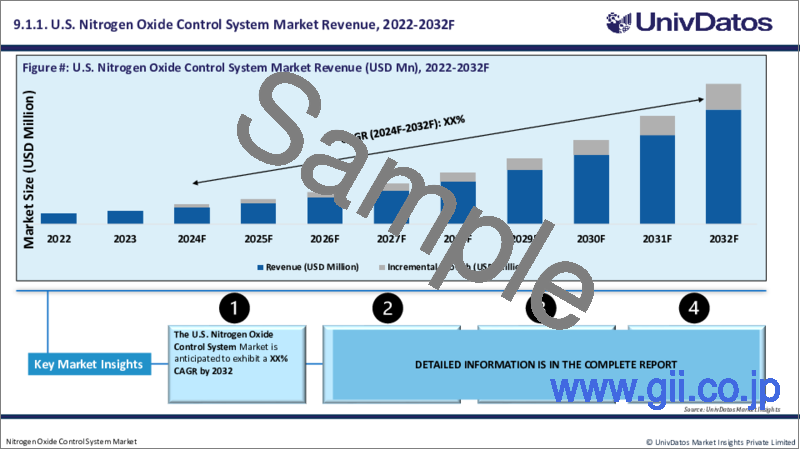|
|
市場調査レポート
商品コード
1479090
窒素酸化物制御システム市場:現状分析と予測(2023-2030年)Nitrogen Oxide Control System Market: Current Analysis and Forecast (2023-2030) |
||||||
カスタマイズ可能
|
|||||||
| 窒素酸化物制御システム市場:現状分析と予測(2023-2030年) |
|
出版日: 2024年04月01日
発行: UnivDatos Market Insights Pvt Ltd
ページ情報: 英文 125 Pages
納期: 即日から翌営業日
|
全表示
- 概要
- 目次
窒素酸化物制御システム市場は、大気汚染に対する懸念の高まりと、この問題に関する各国政府の厳しい規制により、CAGR約5.8%の力強い成長が見込まれています。窒素酸化物(NOx)は、大気汚染の主な原因であり、スモッグ、酸性雨、地上オゾンの形成に寄与する反応性の高いガス群です。これらのガスは主に、発電所、工業施設、自動車における化石燃料の燃焼によって排出されます。大気の質に対する懸念や、それが人の健康や環境に与える影響が高まり続ける中、効果的な窒素酸化物制御システムに対する需要は世界中で急速に高まっています。さらに、世界各国の政府は、大気汚染を抑制し、窒素酸化物が環境に与える影響を軽減するために、厳しい排出基準を導入しています。例えば、米国環境保護庁(EPA)は2024年2月、NOxの国家大気質基準(NAAQS)を強化し、心臓発作や早死などの有害で費用のかかる健康への影響から国民を守ることを目的として、NOxを制限しました。
技術に基づき、市場は選択的触媒還元(SCR)、選択的無触媒還元(SNCR)、低NOxバーナー、燃料再燃焼に分類されます。選択的触媒還元(SCR)は、市場シェアと普及率の点で圧倒的なセグメントとして際立っています。産業用および公益用ボイラーからの窒素酸化物(NOx)排出の抑制は、環境に関する大きな関心事です。NOxを削減するために、選択的触媒還元(SCR)、選択的無触媒還元(SNCR)、低NOxバーナー、燃料再燃焼など、さまざまな技術が開発されてきました。これらの技術の中で、SCRは現在NOx制御システム市場で圧倒的なシェアを占めています。SCRは最大90%以上のNOx削減効率を達成できるため、厳しい排出規制を満たすための最も効果的な技術となっています。さらに、SCRシステムは適用範囲が広く、既存のボイラーやその他の燃焼源に後付けできるほか、発電、セメント、化学、精製など、さまざまな業界の新設設備に組み込むこともできます。さらに、SCRシステムは幅広い温度と負荷条件で運転できるため、さまざまな運転シナリオでNOx排出を柔軟に制御できます。このような市場開拓は、SCR NOx制御システムの市場における重要性を示すとともに、予測期間を通じてその成長軌道を支える有利なシナリオを生み出しています。
市場は用途に基づき、発電・エネルギー、化学、輸送、工業に区分されます。窒素酸化物(NOx)は、さまざまな産業、運輸、発電、化学プラントにおける燃焼プロセス中に放出される有害な汚染物質です。NOx排出による環境への影響に対処するため、世界市場ではさまざまな分野でNOx制御システムの需要が大幅に増加しています。NOx制御システムの市場収益と広範な採用という点では、発電とエネルギーが支配的なセグメントとして際立っています。発電・エネルギー分野でNOx制御システムの採用を促進する主な要因には、規制遵守が含まれます。窒素酸化物(NOx)は、発電所における石炭・天然ガス・石油などの化石燃料の燃焼によって発生する一般的な汚染物質です。NOxの排出は、スモッグ、酸性雨、大気質悪化の主な原因となっています。これに対抗するため、世界各国の政府は、発電施設から排出されるNOxの許容量に上限を設ける厳しい規制を実施しています。米国環境保護庁の酸性雨プログラム、欧州連合の産業排出指令、中国の超低排出基準は、電力セクターのNOx規制を推進する規制の一例に過ぎないです。制限値を超えた発電所は、多額の罰金と罰則に直面します。さらに、発電所、特に石炭火力発電所は、NOx排出の最大の定置発生源のひとつです。一つの石炭火力発電所が排出するNOxは年間数千トンにのぼる。このような大規模な点発生源を制御することは、小規模な分散型発生源を対象とするよりも効果的であるため、NOx制御システムは発電所にとって極めて重要です。このような要因が、発電・エネルギーにおけるNOx制御システムの広範な採用を促進する環境を作り出しています。
窒素酸化物制御システムの市場導入に関する理解を深めるため、市場は北米(米国、カナダ、その他北米地域)、欧州(ドイツ、英国、フランス、その他欧州地域)、アジア太平洋地域(中国、日本、インド、韓国、その他アジア太平洋地域)、世界のその他の地域における世界の存在に基づいて分析されています。アジア太平洋地域は、さまざまな産業で窒素酸化物(NOx)制御システムの採用が急増しています。都市化の進展、電力需要の増加、排出ガスが環境に与える影響に対する懸念の高まりなど、いくつかの要因がこの普及を後押ししています。アジア太平洋地域の政府は、気候変動への対応と温室効果ガス排出量削減の重要性を認識しつつあります。いくつかの国は、NOx制御システムを含むクリーン技術の採用を促進するための政策やイニシアチブを実施しています。例えば、日本の経済産業省(METI)は、排ガス規制技術を導入する産業に対し、様々な補助金や税制優遇措置を導入しています。同様に、韓国の排ガス規制技術開発プログラムは、先進排ガス規制システムの開発と商業化を支援することを目的としています。さらに、アジア太平洋地域では、急速な工業化と人口増加により電力需要が急増しています。例えば、国際エネルギー機関(IEA)によると、この地域の電力需要は2040年までに60%近く増加すると予想されています。この電力需要の増加には、主に石炭火力発電所と天然ガス火力発電所が対応しており、これらはNOx排出の重大な原因となっています。これらの発電所が環境に与える影響を軽減するため、この地域の国々はNOx制御システムの設置を義務付けています。例えば、インドの環境・森林・気候変動省は、火力発電所に対する厳しいNOx排出規制を設定し、選択的触媒還元(SCR)および選択的無触媒還元(SNCR)システムの採用を推進しています。こうした要因が追い風となり、予測期間を通じてアジア太平洋地域のNOx制御システムの成長軌道を支えています。
同市場で事業を展開する主要企業には、 Honeywell International Inc.;CECO ENVIRONMENTAL; John Wood Group PLC; MITSUBISHI HEAVY INDUSTRIES, LTD.; DUCON Environmental; Babcock & Wilcox Enterprises, Inc; Siemens Energy; Phinia Inc.; Yara; and Spraying Systems Co.
目次
第1章 市場イントロダクション
- 市場の定義
- 主な目標
- ステークホルダー
- 制限事項
第2章 調査手法または前提条件
- 調査プロセス
- 調査手法
- 回答者プロファイル
第3章 市場要約
第4章 エグゼクティブサマリー
第5章 COVID-19が窒素酸化物制御システム市場に与える影響
第6章 窒素酸化物制御システム市場収益 , 2020-2030年
第7章 テクノロジー別市場洞察
- 選択触媒還元(SCR)
- 選択的非触媒還元(SNCR)
- 低NOxバーナー
- 燃料の再燃焼
第8章 アプリケーション別の市場分析
- 発電とエネルギー
- 化学薬品
- 交通機関
- 産業
第9章 地域別市場分析
- 北米
- 米国
- カナダ
- その他北米地域
- 欧州
- ドイツ
- 英国
- フランス
- イタリア
- その他欧州地域
- アジア太平洋
- 中国
- インド
- 日本
- 韓国
- その他アジア太平洋地域
- 世界のその他の地域
第10章 窒素酸化物制御システム市場力学
- 市場促進要因
- 市場の課題
- 影響分析
第11章 窒素酸化物制御システム市場機会
第12章 窒素酸化物制御システム市場動向
第13章 需要と供給の分析
- 需要側分析
- 供給側分析
第14章 バリューチェーン分析
第15章 競争シナリオ
- 競合情勢
- ポーターのファイブフォース分析
第16章 会社概要
- Honeywell International Inc.
- CECO ENVIRONMENTAL
- John Wood Group PLC
- MITSUBISHI HEAVY INDUSTRIES, LTD.
- DUCON Environmental
- Babcock & Wilcox Enterprises, Inc
- Siemens Energy
- Phinia Inc.
- Yara
- Spraying Systems Co.
第17章 免責事項
A nitrogen oxide (NOx) control system is a set of technologies and measures implemented in various industrial processes and combustion systems to reduce the formation and emission of nitrogen oxides. Nitrogen oxides, primarily nitric oxide (NO) and nitrogen dioxide (NO2) are air pollutants that contribute to acid rain, ground-level ozone formation, and respiratory health issues. The primary objective of a NOx control system is to minimize the formation of nitrogen oxides during combustion processes or to remove them from the exhaust gases before they are released into the atmosphere. These systems are commonly employed in power plants, industrial furnaces, boilers, and vehicles.
The Nitrogen Oxide Control System Market is expected to grow at a strong CAGR of around 5.8% owing to the growing concerns about air pollution and governments' stringent regulations regarding this issue. Nitrogen oxides (NOx) are a group of highly reactive gases that are a major source of air pollution, contributing to the formation of smog, acid rain, and ground-level ozone. These gases are primarily emitted from the combustion of fossil fuels in power plants, industrial facilities, and vehicles. As concerns over air quality and its impact on human health and the environment continue to rise, the demand for effective nitrogen oxide control systems has been growing rapidly worldwide. Furthermore, Governments around the world have implemented stringent emission standards to curb air pollution and reduce the environmental impact of nitrogen oxides. For instance, in February 2024, the U.S. Environmental Protection Agency (EPA) strengthened National Ambient Air Quality Standards (NAAQS) for NOx, limiting it, aiming to protect its population from harmful and expensive health impacts, such as heart attack and premature deaths.
Based on the technology, the market is categorized into selective catalytic reduction (SCR), selective non-catalytic reduction (SNCR), low NOx burner, and fuel reburning. Selective catalytic reduction (SCR) stands out as a dominant segment in terms of market share and widespread adoption. The control of nitrogen oxide (NOx) emissions from industrial and utility boilers is a major environmental concern. Various technologies have been developed to reduce NOx, including selective catalytic reduction (SCR), selective non-catalytic reduction (SNCR), low NOx burners, and fuel reburning. Among these technologies, SCR currently holds the dominant share of the NOx control systems market. SCR can achieve NOx reduction efficiencies of up to 90% or higher, making it the most effective technology for meeting stringent emission regulations. Furthermore, SCR systems exhibit broad applicability and can be retrofitted to existing boilers and other combustion sources, as well as integrated into new installations across various industries, such as power generation, cement, chemical, and refining. Additionally, SCR systems can operate over a wide range of temperatures and load conditions, providing flexibility in controlling NOx emissions during varying operational scenarios. These developments along with others demonstrate the significance of SCR NOx control systems in the markets, creating a favorable scenario supporting its growth trajectory throughout the forecast period.
Based on the application, the market is segmented into power generation & energy, chemical, transportation, and industrial. Nitrogen Oxides (NOx) are harmful pollutants released during combustion processes in various industries, transportation, power generation, and chemical plants. To combat the environmental impact of NOx emissions, the global market has seen a significant rise in the demand for NOx control systems across different sectors. Among the sectors mentioned, power generation & energy stands out as a dominant segment in terms of market revenue and widespread adoption of NOx control systems. The primary factor driving the adoption of NOx control systems in power generation & energy includes regulatory compliance. Nitrogen oxides (NOx) are a prevalent pollutant produced from the combustion of fossil fuels like coal, natural gas, and oil in power plants. NOx emissions are a major contributor to smog, acid rain, and poor air quality. To combat this, governments globally have implemented stringent regulations capping the allowable NOx emissions from power generation facilities. The U.S. Environmental Protection Agency's Acid Rain Program, the European Union's Industrial Emissions Directive, and China's Ultra-Low Emissions Standards are just some examples of the regulations driving NOx control in the power sector. Plants exceeding limits face hefty fines and penalties. Furthermore, Power plants, especially those fired by coal, are among the largest stationary sources of NOx emissions. A single coal-fired plant can emit thousands of tons of NOx per year. Controlling these large point sources is more effective than targeting smaller distributed sources, making NOx control systems crucial for power plants. Factors such as these are creating a conducive environment, driving widespread adoption of NOx control systems in power generation & energy.
For a better understanding of the market adoption of the Nitrogen Oxide Control Systems system, the market is analyzed based on its worldwide presence in countries such as North America (The U.S., Canada, and the Rest of North America), Europe (Germany, The U.K., France, Rest of Europe), Asia-Pacific (China, Japan, India, South Korea, Rest of Asia-Pacific), Rest of World. The Asia Pacific region is witnessing rapid growth in the adoption of nitrogen oxide (NOx) control systems across various industries. Several factors are driving this widespread adoption, fueled by increasing urbanization, rising power demand, and growing concerns about the environmental impact of emissions. Governments in the Asia Pacific region are increasingly recognizing the importance of addressing climate change and reducing greenhouse gas emissions. Several countries have implemented policies and initiatives to promote the adoption of clean technologies, including NOx control systems. For instance, Japan's Ministry of Economy, Trade, and Industry (METI) has introduced various subsidies and tax incentives for industries implementing emission control technologies. Similarly, South Korea's Emission Control Technology Development Program aims to support the development and commercialization of advanced emission control systems. Furthermore, the Asia Pacific region is experiencing a surge in power demand due to rapid industrialization and population growth. For instance, according to the International Energy Agency (IEA), the region's electricity demand is expected to grow by nearly 60% by 2040. This increasing demand for power is primarily being met by coal-fired and natural gas-fired power plants, which are significant sources of NOx emissions. To mitigate the environmental impact of these power plants, countries in the region are mandating the installation of NOx control systems. For example, India's Ministry of Environment, Forest, and Climate Change has set stringent NOx emission limits for thermal power plants, driving the adoption of selective catalytic reduction (SCR) and selective non-catalytic reduction (SNCR) systems. Factors such as these are creating favorable tailwinds, supporting the growth trajectory of the Asia Pacific NOx control system throughout the forecast period.
Some of the major players operating in the market include Honeywell International Inc.; CECO ENVIRONMENTAL; John Wood Group PLC; MITSUBISHI HEAVY INDUSTRIES, LTD.; DUCON Environmental; Babcock & Wilcox Enterprises, Inc; Siemens Energy; Phinia Inc.; Yara; and Spraying Systems Co.
TABLE OF CONTENTS
1MARKET INTRODUCTION
- 1.1.Market Definitions
- 1.2.Main Objective
- 1.3.Stakeholders
- 1.4.Limitation
2RESEARCH METHODOLOGY OR ASSUMPTION
- 2.1.Research Process of the Nitrogen Oxide Control System Market
- 2.2.Research Methodology of the Nitrogen Oxide Control System Market
- 2.3.Respondent Profile
3MARKET SYNOPSIS
4EXECUTIVE SUMMARY
5IMPACT OF COVID-19 ON THE NITROGEN OXIDE CONTROL SYSTEM MARKET
6NITROGEN OXIDE CONTROL SYSTEM MARKET REVENUE (USD BN), 2020-2030F.
7MARKET INSIGHTS BY TECHNOLOGY
- 7.1.Selective Catalytic Reduction (SCR)
- 7.2.Selective Non-Catalytic Reduction (SNCR)
- 7.3.Low NOx Burner
- 7.4.Fuel Reburning
8MARKET INSIGHTS BY APPLICATION
- 8.1.Power Generation and Energy
- 8.2.Chemical
- 8.3.Transportation
- 8.4.Industrial
9MARKET INSIGHTS BY REGION
- 9.1.North America
- 9.1.1.The U.S.
- 9.1.2.Canada
- 9.1.3.Rest of North America
- 9.2.Europe
- 9.2.1.Germany
- 9.2.2.The U.K.
- 9.2.3.France
- 9.2.4.Italy
- 9.2.5.Rest of Europe
- 9.3.Asia-Pacific
- 9.3.1.China
- 9.3.2.India
- 9.3.3.Japan
- 9.3.4.South Korea
- 9.3.5.Rest of Asia-Pacific
- 9.4.Rest of the World
10NITROGEN OXIDE CONTROL SYSTEM MARKET DYNAMICS
- 10.1.Market Drivers
- 10.2.Market Challenges
- 10.3.Impact Analysis
11NITROGEN OXIDE CONTROL SYSTEM MARKET OPPORTUNITIES
12NITROGEN OXIDE CONTROL SYSTEM MARKET TRENDS
13DEMAND AND SUPPLY-SIDE ANALYSIS
- 13.1.Demand Side Analysis
- 13.2.Supply Side Analysis
14VALUE CHAIN ANALYSIS
15COMPETITIVE SCENARIO
- 15.1.Competitive Landscape
- 15.1.1.Porters Fiver Forces Analysis
16COMPANY PROFILED
- 16.1.Honeywell International Inc.
- 16.2.CECO ENVIRONMENTAL
- 16.3.John Wood Group PLC
- 16.4.MITSUBISHI HEAVY INDUSTRIES, LTD.
- 16.5.DUCON Environmental
- 16.6.Babcock & Wilcox Enterprises, Inc
- 16.7.Siemens Energy
- 16.8.Phinia Inc.
- 16.9.Yara
- 16.10.Spraying Systems Co.






